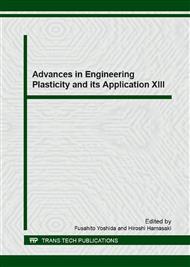p.610
p.616
p.623
p.630
p.636
p.641
p.647
p.653
p.659
Study on Magnesium Alloy Thin Sheet by Symmetric Rolling and Asymmetric Rolling Process
Abstract:
Magnesium alloy is honored as green engineering material for its low density, high specific strength, high specific rigidity, well cutting processing property, well electromagnetic shielding property, heat conduction and easy to recycle. In this paper, AZ31 Magnesium alloy sheet at difference thickness were prepared by symmetric and asymmetric rolling employed with six-roller mill. Microstructure of the two kinds of rolling magnesium alloy thin sheets at 0.5mm thickness were investigated. The grain distribution of AZ31magnesium alloy sheets made by asymmetry rolling at room temperature are more uniform than those made by symmetry process. The grains made by asymmetry are more tiny and the tensile strength and elongation increased obviously and the mechanical properties got better. At room temperature, value of n increased. Large value of n benefit to stamping forming. At room temperature, the value of LDR of asymmetry rolling sheets is 1.26, which was higher than symmetry rolling. So asymmetry rolling benefits to stamping forming.
Info:
Periodical:
Pages:
636-640
Citation:
Online since:
December 2016
Authors:
Price:
Сopyright:
© 2017 Trans Tech Publications Ltd. All Rights Reserved
Share:
Citation:


